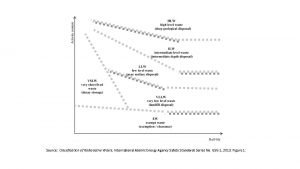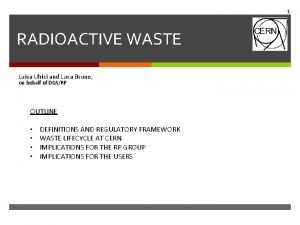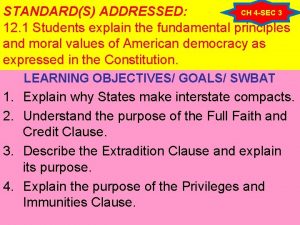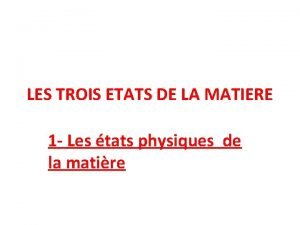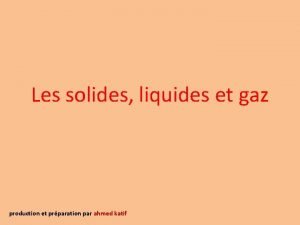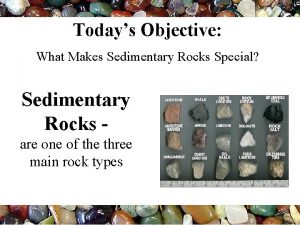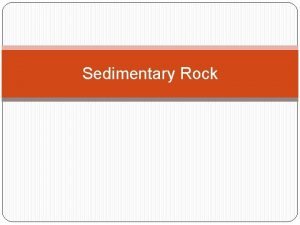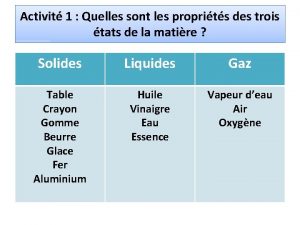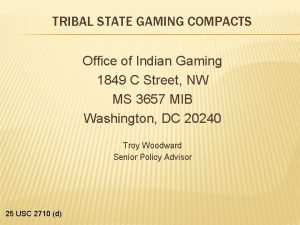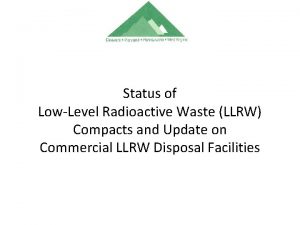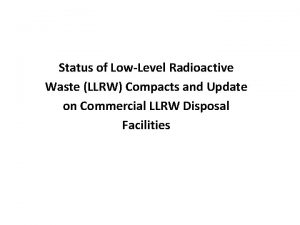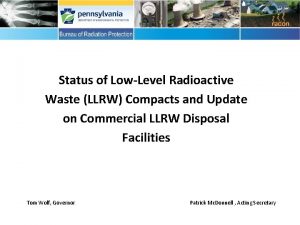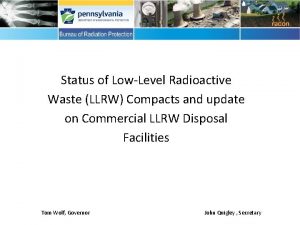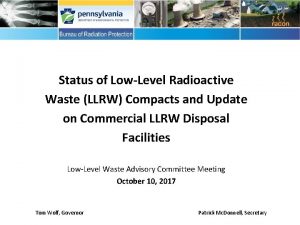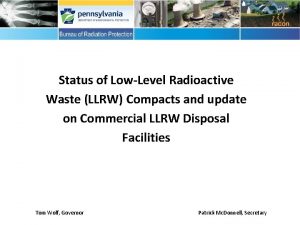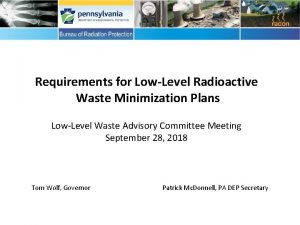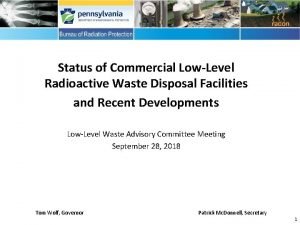Status of LowLevel Radioactive Waste LLRW Compacts and











- Slides: 11

Status of Low-Level Radioactive Waste (LLRW) Compacts and Update on Commercial LLRW Disposal Facilities

Background - Federal Legislation Federal Low-Level Radioactive Waste Policy Act Ø States Responsible Ø Compacts Encouraged Ø Exclusion of Out-of-Compact Waste

Status of LLRW Compacts

Status of Commercial LLRW Disposal Facilities Ø Barnwell Disposal Facility in South Carolina (Regional Facility) Ø Accepts Class A, B and C wastes from the Atlantic Compact (CT, NJ, SC) Ø Closed to generators outside the Atlantic Compact as of July 1, 2008 Ø Current projected closure date is 2038 Ø Richland Facility in Washington (Regional Facility) Ø Accepts Class A, B and C wastes from the Northwest and Rocky Mountain Compacts (11 states in 2 compacts) Ø Accepts NARM waste from states throughout the nation Ø Current projected closure date is 2056 Ø Energy Solutions Facility in Utah (not a Regional Facility) Ø Accepts Class A waste from the entire nation except the Northwest and Rocky Mountain Compacts Ø Provides for disposal of bulk waste, containerized waste, large components, and mixed waste Ø Transports large components such as steam generators for disposal

Status of Commercial LLRW Disposal Facilities (Energy. Solutions Cont. ) Ø Regulatory review for disposal of large quantities of depleted uranium (DU) underway Ø Utah granted license variance for disposal of Class A sealed sources Received and managed 41, 190 sealed sources between 2013 and 2015 under the CRCPD Source Collection and Threat Reduction (SCATR) Program Ø Approval for disposal of Class A sealed sources has been requested and is part of the permanent license amendment Ø Current projected closure date is 2050

Status of Commercial LLRW Disposal Facilities Ø WCS Disposal Facility in Texas (Regional Facility) ― Two facilities: one license • Compact facility (initially licensed for 2. 3 Mft³ and 3. 9 MCi) • Federal facility for DOE waste (26 Mft³ and 5. 6 MCi) Ø Accepts commercial LLRW (Class A, B and C) and federal LLRW and mixed waste Ø Annual limit on radioactivity of out-of-compact waste is 275, 000 Ci Ø No annual limit on volume of out-of-compact waste Ø Volume expansion from 2. 3 Mft³ to 9 Mft³ granted by TCEQ Ø Disposal of Depleted Uranium (DU) and Greater-Than-Class C (GTCC) waste is being considered Ø Current projected closure date is 2045 TCEQ – Texas Commission on Environmental Quality

Recent Developments Ø DOE issued Final EIS for Disposal of Greater-Than-Class C (GTCC) lowlevel radioactive waste (DOE/EIS-0375) Ø SHINE Medical Technologies receives construction permit from NRC for a medical isotope production facility in Janesville, WI Ø NRC releases results of Byproduct Material Financial Scoping Study including recommendations for next step (SECY-16 -0046) Ø NRC releases final 10 CFR Part 61 rule for Commission approval (SECY 16 -0106)

DOE Issues Final EIS on GTCC Waste Disposal Ø In February 2016, DOE issued the final EIS for GTCC LLRW and GTCC-like waste (DOE/EIS-0375 D) Ø Currently, there is no disposal capability for GTCC waste (420, 000 ftᶟ, 160 MCi) Ø DOE reviewed five alternative options for disposal of GTCC waste Ø The preferred alternative is disposal at WIPP and/or land disposal at generic commercial facilities Ø DOE will submit a report to the Congress on disposal alternatives and await action by Congress before it issues a Record of Decision

SHINE Receives Construction Permit from NRC Ø In February 2016, NRC issued a construction permit to SHINE Medical Technologies for a facility (57, 000 ft²) in Janesville, WI Ø The facility will produce molybdenum-99 (Mo-99) through fission of lowenriched uranium (<20%) Ø Mo-99 has not been produced for medical use in the U. S. for more than two decades Ø SHINE applied for the permit in 2013 and NRC completed it technical review in October 2015 under 10 CFR Part 50 Ø Construction is expected to begin in early 2017 and SHINE expects to begin commercial sales from the facility in early 2019 Ø PEC, Inc. has informed NRC of its intention to begin the licensing process for an Mo-99 production facility in Utah

NRC Releases Results of Byproduct Material Financial Scoping Study Ø In April 2016, NRC released the results of Byproduct Material Financial Scoping Study and its recommendations (SECY-16 -0046) Ø NRC reviewed current regulations and guidance, internal and external reports, and received feedback from the stakeholders Ø NRC recommends that financial assurance requirements in Part 30. 35 be expanded to include byproduct material Category 1 and 2 sealed sources that are in the NSTS Ø NRC staff plans to develop a rulemaking plan SECY paper to the Commission to initiate rulemaking NSTS – National Source Tracking System

Categories of Radioactive Sealed Sources • Category 1: greater than or equal to Category 1 threshold (e. g. , for Co-60: 810 Ci) – irradiators, teletherapy machines • Category 2: less than the Category 1 threshold but equal to or greater than the Category 2 threshold - 1/100 th of Category 1 (e. g. , for Co-60: 8. 1 Ci) – industrial gamma radiography equipment, well logging gauges • Category 3: less than the Category 2 threshold but equal to or greater than the Category 3 threshold - 1/10 th of Category 2 (e. g. , for Co-60: 0. 81 Ci) – industrial gauges, industrial calibration sources • Category 4: less than the Category 3 threshold but equal or greater than the Category 4 threshold -1/100 th of Category 3 (e. g. , for Co-60: 0. 0081 Ci) ‒ thickness gauges, bone densitometers • Category 5: less than the Category 4 threshold down to *IAEA exempt quantities – x-ray fluorescence devices, static eliminators *IAEA – International Atomic Energy Agency
 Radiation pollution conclusion
Radiation pollution conclusion Radioactive nuclear waste
Radioactive nuclear waste Radioactive waste
Radioactive waste Privileges and immunities clause examples
Privileges and immunities clause examples Les solides compacts
Les solides compacts Les solides compacts
Les solides compacts Les corps solides compacts
Les corps solides compacts A process that squeezes or compacts sediments
A process that squeezes or compacts sediments Sedimentary rock
Sedimentary rock Features of sedimentary rocks
Features of sedimentary rocks Les solides pulvérisés
Les solides pulvérisés Indian gaming compacts
Indian gaming compacts

